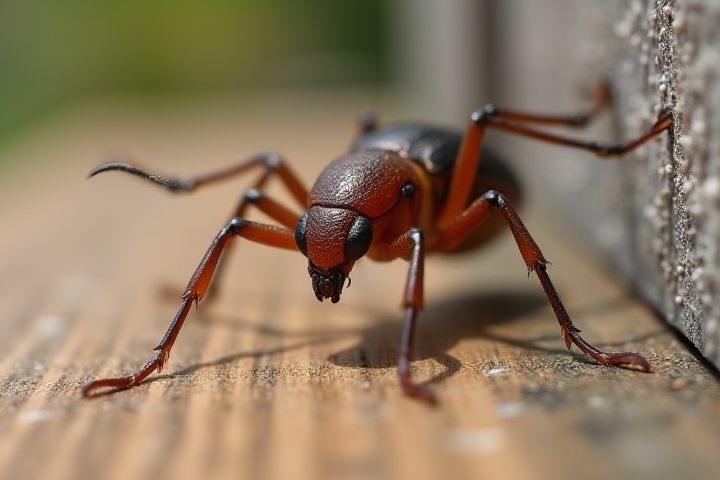
To effectively pest-proof your house, start by sealing any cracks and gaps in walls, windows, and door frames with high-quality caulk or weather stripping, creating a barrier against insects and rodents. Ensure that all food is stored in airtight containers, as this prevents attracting pests that seek nourishment. Regularly inspect and maintain your home's plumbing and drainage systems to eliminate standing water, a breeding ground for pests like mosquitoes. You should also keep the yard tidy by trimming vegetation and removing debris, which can harbor pests close to your home. Lastly, consider installing screens on windows and vents, allowing airflow while keeping unwanted intruders out.
How To Pest-Proof A House
Seal entry points
To effectively pest-proof your house, focus on sealing entry points that pests use to invade. Inspect windows, doors, and gaps around pipes and wires, and use caulk or weather stripping to close any openings. Consider installing door sweeps on exterior doors and ensuring window screens are intact and free of tears. By systematically addressing these entry points, you can significantly reduce the likelihood of pests entering your home.
Maintain yard cleanliness
Maintaining yard cleanliness is crucial for pest-proofing your home, as debris and clutter can harbor insects and rodents. Regularly remove leaves, grass clippings, and any organic matter from your yard, ensuring that there are no breeding grounds for pests. Trim shrubs and trees to create a gap between vegetation and your home, ideally six inches, to minimize the chances of pests making their way indoors. Additionally, store firewood, compost, and other outdoor materials away from the house, ideally at least 20 feet to further deter unwanted critters.
Store food properly
Store food in airtight containers to prevent pests like ants, roaches, and rodents from gaining access. Keep your pantry organized and regularly check for expired items, as removing old food reduces attraction for unwanted insects. Ensure all food storage areas are clean, with surfaces wiped down to eliminate crumbs and spills that may lure pests. Consider using vacuum sealing for long-term storage of perishable goods, enhancing both freshness and pest-proofing.
Manage waste disposal
Effective waste disposal management is crucial for pest-proofing your house. Regularly empty trash bins and ensure they have tightly fitting lids to prevent attracting rodents and insects. Composting should be done with care; keep compost bins away from the house and secure them to deter pests. Always clean up food spills and residue promptly, as these can serve as food sources for various pests.
Install weather stripping
Installing weather stripping can significantly enhance your home's defense against pests. By sealing gaps around doors and windows, weather stripping prevents insects and rodents from entering your living spaces, creating a more comfortable environment. Properly applied weather stripping can fit snugly in openings as small as 1/8 inch, which is a common entry point for many pests. Regularly inspect and replace worn or damaged strips to maintain effectiveness and ensure your home stays pest-free.
Use pest deterrents
To effectively pest-proof your house, consider using natural pest deterrents such as essential oils and vinegar, which can repel insects like spiders and ants. Deploying diatomaceous earth in strategic locations acts as a physical barrier against crawling pests by damaging their exoskeletons. You may also find that planting pest-repelling plants, such as mint and lavender, around your home can create an aromatic barrier while enhancing your outdoor aesthetics. Implementing these tactics will help create an inhospitable environment for pests while promoting a healthier living space for you and your family.
Fix leaks and drips
Fixing leaks and drips is essential for pest-proofing your house, as moisture attracts various insects and rodents. Inspect areas under sinks, around toilets, and in your basement or crawl space for any signs of water accumulation. According to the CDC, a single leaking faucet can waste more than 3,000 gallons of water a year, creating an inviting environment for pests. Sealing these leaks not only saves water but also significantly reduces the chances of pest infestations, ensuring a healthier living space for you and your family.
Trim vegetation
To effectively pest-proof your house, start by trimming back vegetation that is in close proximity to your foundation. Overgrown shrubs and trees can create a bridge for pests to access your home, so maintain a clearance of at least 12 inches between plants and the structure. Regularly cut back grasses and weeds that can harbor insects, and ensure that any branches are not touching your roof, as this can allow pests easy entry. Implementing this practice not only reduces pest access but also promotes better air circulation around your home, minimizing damp areas that attract unwanted infestations.
Declutter regularly
Regular decluttering is essential in pest-proofing your home, as it eliminates hiding spots and breeding grounds for unwanted insects and rodents. You should regularly assess areas like basements, attics, and garages, removing unnecessary items that accumulate dust and debris, which attract pests. Store food in airtight containers and dispose of cardboard boxes, as they can harbor pests such as cockroaches or mice. Creating a tidy environment not only deters infestations but also enhances your living space's overall cleanliness and safety.
Inspect regularly
Inspecting your home regularly is crucial for effective pest-proofing. Aim to conduct inspections at least once a month; pay close attention to entry points, such as cracks in walls or gaps around windows and doors, as pests can enter through openings as small as 1/16 of an inch. Monitor areas prone to moisture, like kitchens and basements, since damp environments attract pests like termites and cockroaches. Keep your yard tidy by trimming bushes and removing debris; doing so not only enhances your home's appearance but also reduces pests' habitats outside your lawn.
